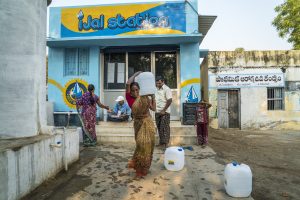Innovative decentralized water solutions developed by social enterprises
This blog draws on the findings from research conducted on innovative social enterprise models at the Base of the Pyramid for the World Bank Social Enterprise Innovations team by Endeva and Ashley Insight. The research and corresponding case studies are available on the World Bank and OECD’s Innovation Policy Platform. Read about the models in the Water and Sanitation sector here (not longer available).
The great news is that there is a growing number of social enterprises proving them wrong!

In urban and peri-urban areas, piped utility water is often not provided to low-income communities. The cost of laying down pipes and the difficulties of collecting money from consumers (and absorbing losses from local ‘water barons’ stealing the water) will push prices beyond what the utility can afford – so the pipes stop at the edge of where these people live.
In rural areas, there is no piped water because consumers are too dispersed for this to make financial sense. However, most people can dig a well or protect a spring. This provides them with water that is either already clean or can be boiled to make it safe. But this isn’t true everywhere. There are areas where underground water has severe microbial pollution, or is contaminated in other ways such as by high arsenic, fluoride, iron or nitrate content. This water, even if boiled, leads to long term health damage if drunk regularly.
It is mainly as a response to this rural water challenge that a range of social enterprises have developed business models that show that, even in these circumstances, clean and safe drinking water can be provided to people at an affordable cost with minimal or zero long-term subsidy involved. So successful have these models been that they are now spreading into peri-urban and urban communities which are otherwise being under served by the mainstream providers.
Last year I researched these business models as part of wider work for the World Bank on innovative business models at the BoP. I talked to representatives of two of the most successful social enterprises in this space – Safe Water Network and WaterHealth International. While most of the successful examples are in rural India there are now some enterprises making the model work in Sub-Saharan Africa, such as WaterHealth, who by 2012 had 500 sites across the world and were estimated by the World Bank to have 5 million customers.

- There is a lead organization, which is most often a social enterprise but can be an NGO;
- Site selection is based on demand and willingness to pay for safe water, and a desire from the community to collaborate;
- Agreements will be reached with the appropriate local authority for access to a water source and, if needed, a license to extract water. The community may also provide land for the enterprise to set up the treatment plant;
- The lead organization brings the investment capital and technical expertise, procures and installs appropriate filtration equipment, and provides a system for maintenance and quality control. .
There are also some variations in the model. The enterprise that actually filters and sells the water can be the lead organization or it can be a third party business with private or community ownership. The water sale point may be a ‘kiosk’ set up purely to sell water, part of a general store selling other goods or part of a wider health and/or sanitation offering. Sometimes a hand delivery service is offered or micro-entrepreneurs offer delivery services.
The financial model can also vary. Some lead organizations have been able to reclaim most of the capital costs from the operational enterprise over time, but in other cases these costs are covered by a donor. This can depend on the nature of water contamination (with some contaminants requiring very expensive filtration equipment), consumer ability to pay for water or just a different cost structure.
My research for the World Bank project led me to the following conclusions:
Target group: By definition the model reaches those with few other options aside from drinking contaminated local water or paying for expensive bottled water. However, very poor people may still be unable to pay for the treated water.
Benefit to end-users: These models do make water safe at the point of sale as long as there is frequent testing and good maintenance. However, if there is no control over distribution, recontamination of the water can easily happen.
Access to capital: The ability to access grant or appropriate equity finance is a major determinant of the rate of growth that is possible, given that most organizations using this model depend on financing for the capital costs.
Skilled personnel: Lack of personnel with the training to install and maintain the treatment plants can be a constraint.
Explicit demand: There can be challenges identifying communities with sufficient demand for safe water and willingness to pay.
In summary, this is an excellent business model for providing safe and clean water on a sustainable basis to consumers who otherwise are not being reached by mainstream water providers. It is most likely to spread in areas where the following factors are in place:
- Contaminated local water sources and absence of piped/utility water;
- Community demand for treated water and willingness to pay;
- Capital for investment, either from grants or patient investment;
- Supportive local authorities and permission to use land and water;
- Access to skilled personnel.
This blog is part of the October 2016 series on Exploring the social enterprise landscape, in partnership with the World Bank Group and endeva. Read the whole series for insight and opinion on policy, business models and definitions from social entrepreneurs, policy makers and facilitators around the world.